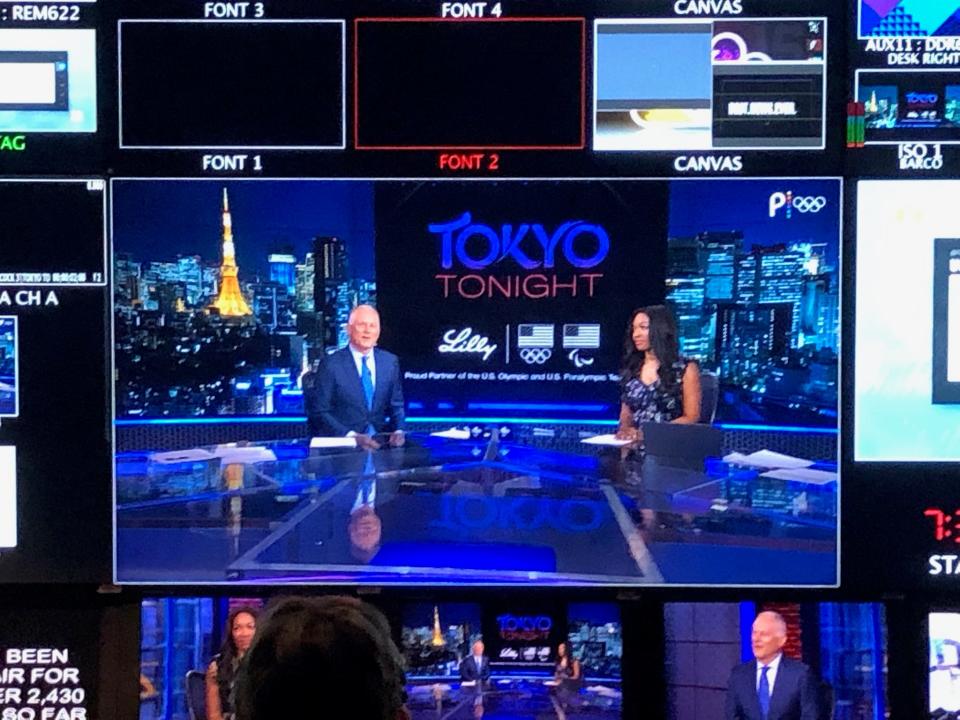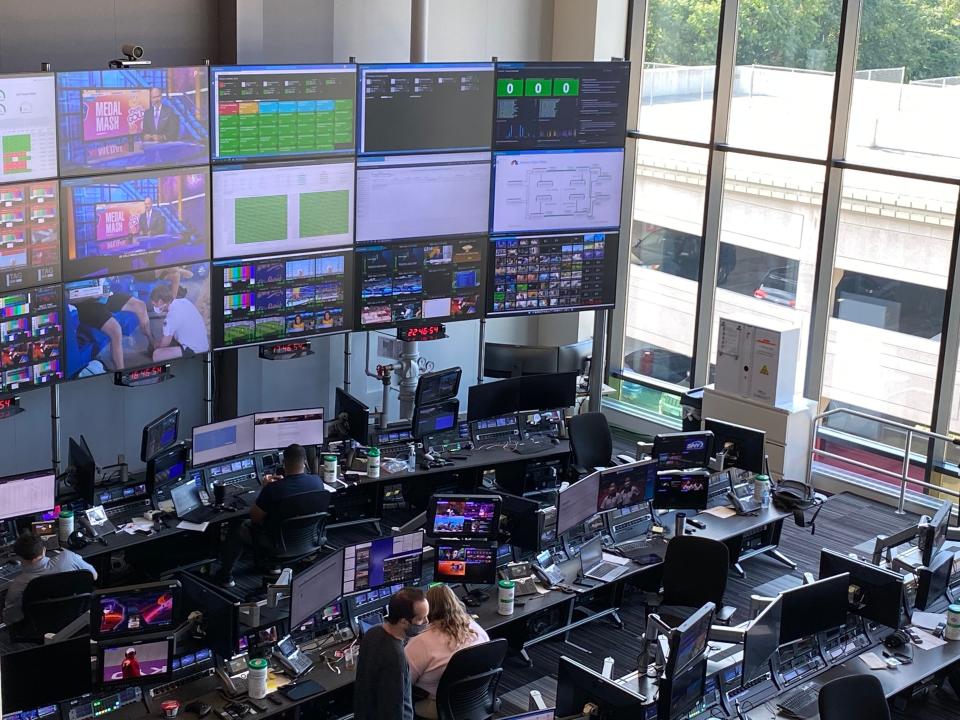Ever wonder how NBC's Olympic coverage comes together? It starts in an old warehouse
- Oops!Something went wrong.Please try again later.
- Oops!Something went wrong.Please try again later.
STAMFORD, Conn. – In 2011, NBC while looking for a place to set up shop for its sports department, stumbled upon a Clairol shampoo warehouse in this quaint Eastern Connecticut town about 40 miles northeast of New York City. No one envisioned it would play a crucial part of the network’s vast array of sports properties.
Ten years later, that warehouse space has been converted into one full floor of multiple control rooms and studio space, complete with an existing loading dock so television trucks would have a place to operate.
Although there are nearly 1,600 NBC Olympics employees on-site in Tokyo, most of the behind-the-scenes work is done in Stamford, including the aforementioned production trucks that help viewers watch volleyball, golf, basketball and the swimming events.
“The biggest part is how impressive and large the operation is and continues to grow in the United States and that’s just a product of the changes in technology and the importance of figuring out simple system to create television,” Sam Flood, Executive Producer & President, Production, NBC & NBC Sports Network, told USA TODAY Sports.

Flood has been at NBC since 1986 and is taking part in his 16th Olympics, although the Tokyo Games are the first one where he is not on-site.
Before the 2016 Games in Rio even ended, executives and the production staff were hard at work on the Tokyo Olympics, originally scheduled to start July 24, 2020.
Flood and 1,500 other domestic-based employees are working around the clock at the NBC Sports Group, providing more than 7,000 hours of content (by comparison the 1996 Atlanta Olympics had less than 200 hours of content). It makes for a seamless technical transition with production crews and talent sometimes 6,700 miles away from each other, and sometimes different announcers calling the same event for different digital properties. The approach to this kind of broadcasting is based on the size of the venue and the number of hours that will be telecast.
More: A look at Sydney McLaughlin, Olympic hurdler
More: Biles' bling: Every medal Simone Biles has won at the Olympics
Eight different stateside facilities, include one in Denver, CNBC studios in Englewood Cliffs, New Jersey, and one from Telemundo headquarters in Miami help integrate the vast production.
Flood summed up the massive undertaking this way: “It’s similar to producing six Super Bowls concurrently out of one building.”
In one control room, workers are busy preparing for “Tokyo Tonight,” a show airing nightly on NBC's streaming service, Peacock. Anchored by ex-ESPNers Cari Champion and Kenny Mayne, the show has highlights of events as they happen along with features, interviews with athletes and commentators in Japan.
“Tokyo Tonight” producers Adam Littlefield and Alexa Maremaa described the production during the 4-1/2-hour show as “creative chaos” and likened it to “'SportsCenter'" meets the ‘Today’ show with a mix of NFL Red Zone."
“What we were tasked with from the very beginning was the freedom to create. There is no plan. We literally just slap a bunch of highlights and interviews together and give it to them. It’s a nice little mix,” Littlefield said.
Mayne and Champion, who never anchored together at ESPN, play off each other like old war buddies, especially when the cameras are off, with Mayne teasing her for lack of knowledge of the music catalog of Stevie Wonder, while Champion getting her jabs back at him for her fierce defense of Beyonce.
When asked if he would like to work with Champion again after the Olympics, Mayne’s quirky sense of humor takes over.
“What channel, and how much? I mean, for real,” Mayne says, while laughing but in no way is he joking about scoring his next gig. “It’s the same thing I am discussing with people already. They need to make a bid, it’s getting late.”

After the laughs, it’s back to business for the start of the 7:30 p.m. show. Interviews on this night include shot put silver medalist Raven Saunders, who made an 'X' gesture during her medal ceremony in support of people, the LGBTQ community and those struggling with mental health, and Mike Tirico, the NBC primetime host.
Down the hall of the massive 300,000-plus square foot building, which is set up to resemble the International Broadcast Centre, the focus switches to the primetime show, where most of NBC’s television audience will come from. But there are constant reminders of effects of ongoing pandemic.
There are one of 28 broadcast booths for announcers calling events remotely, each spread apart adhering to some semblance of social distancing and cordoned off by a thick sheet of plexiglass or a piece of wood.
Some booths had to be created by clearing out space in a storage room that was not being used.
Once the coronavirus came into play, job one for the engineers and technical advisors was to adjust their pre-pandemic plan and find more efficient ways to broadcast 24 hours a day because Olympics are planned out years in advance.
“It forced a reevaluation of everything that was in the business plan and the production plan. We recreated how we wanted to do certain sports and events,” Flood said. “I think that's a big indication of the change where you can have the production team halfway around the world.”
NBC also set up a digital production space in a ballroom at a Marriott hotel in downtown Stamford, again making sure employees have space to complete tasks.
For example, coverage of the indoor volleyball tournament, stretches across three continents.
The talent calling the game are stationed in Tokyo, while the sound is being controlled out of Sky Studios in London, all being orchestrated by a director and producer in a room in Stamford.
When an event is shot by cameras in Tokyo, it takes less than five seconds to reach viewers in the United States, says Tim Canary, Vice President, Engineering at NBCUniversal.
“We are thinking about Paris already,” Canary said. “Also, everything we need for Beijing is mostly ready to go. We have to modify a few things. It is all encompassing for the amount of work and the people that are here, so you have to eat and live it at the same time.”
Canary likens his team to air-traffic controllers, responsible for the thousands of feeds looped in from Tokyo. One computer screen alone has nearly 1,000 pictures, including a feed showing Universal Orlando Resort where families can cheer their loved ones competing for gold, USA Network host Kathryn Tappen rehearsing before going live and a promo of WWE Smackdown (another NBCUniversal property headquartered in Stamford).
Over the past 18 months, NBC’s investment ($1.5 billion for the rights to the Tokyo Games alone) has gone from a sure-fire money maker to executives having to explain the logic in broadcasting the Games after Japan declared a state of emergency due to rises in coronavirus cases.
Depending on how the world continues to handle the coronavirus, expect the plan to have split staff when the Winter Games comes to Beijing in six months.
Calls have been made for the Beijing ames to be postponed or canceled, but it is full-steam ahead…for now.
“I think it'll be a very similar plan, based on what is learned. But the group over in Tokyo right now is evaluating what the best next steps for Beijing are,” Flood said. “And obviously with the protocols, we'll have an impact on whatever decisions are made now.”
This article originally appeared on USA TODAY: NBC's Tokyo Games coverage is an exercise in remote work, creativity

